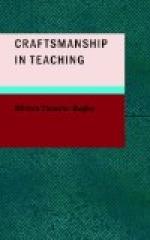And I can formulate my own conception of the work of habit building in education no better than by paraphrasing Klesmer’s epigram. To increase in our pupils the capacity to receive discipline; to show them, through concrete example, over and over again, how persistence and effort and concentration bring results that are worth while; to choose from their own childish experiences the illustrations that will force this lesson home; to supplement, from the stories of great achievements, those illustrations which will inspire them to effort; to lead them to see that Peary conquering the Pole, or Wilbur Wright perfecting the aeroplane, or Morse struggling through long years of hopelessness and discouragement to give the world the electric telegraph,—to show them that these men went through experiences differing only in degree and not in kind from those which characterize every achievement, no matter how small, so long as it is dominated by a unitary purpose; to make the inevitable sloughs of despond no less morasses, perhaps, but to make their conquest add a permanent increment to growth and development: this is the task of our drill work as I view it. As the prophecy of Isaiah has it: “Precept must be upon precept; precept upon precept; line upon line; line upon line; here a little and there a little.” And if we can succeed in giving our pupils this vision,—if we can reveal the deeper meaning of struggle and effort and self-denial and sacrifice shining out through the little details of the day’s work,—we are ourselves achieving something that is richly worth while; for the highest triumph of the teacher’s art is to get his pupils to see, in the small and seemingly trivial affairs of everyday life, the operation of fundamental and eternal principles.
FOOTNOTES:
[Footnote 17: An address before the Kansas State Teachers’ Association, Topeka, October 20, 1910.]
[Footnote 18: W.F. Book, Journal of Educational Psychology, vol. i, 1910, p. 195.]
XII
THE IDEAL TEACHER[19]
I wish to discuss with you briefly a very commonplace and oft-repeated theme,—a theme that has been handled and handled until its once-glorious raiment is now quite threadbare; a theme so full of pitfalls and dangers for one who would attempt its discussion that I have hesitated long before making a choice. I know of no other theme that lends itself so readily to a superficial treatment—of no theme upon which one could find so easily at hand all of the proverbs and platitudes and maxims that one might desire. And so I cannot be expected to say anything upon this topic that has not been said before in a far better manner. But, after all, very few of our thoughts—even of those that we consider to be the most original and worth while—are really new to the world. Most of our thoughts have been thought before. They are like dolls that are passed on from age to age to be dressed up and decorated to suit the taste or the fashion or the fancy of each succeeding generation. But even a new dress may add a touch of newness to an old doll; and a new phrase or a new setting may, for a moment, rejuvenate an old truth.




